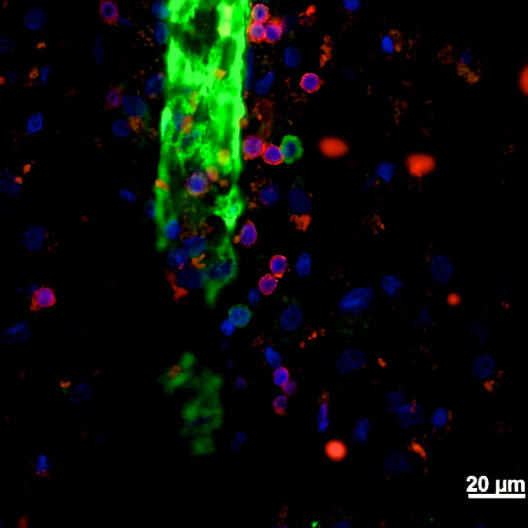How adhesion molecules help pathogenic T-cells to find their way over the blood-brain-barrier

It all started with unexpected cells in the cerebrospinal fluid of MS patients and it ended with a discovery by neuro-immunologists of the university of Münster, which could lead to an improved therapy against MS and other incurable autoimmune diseases.
The scientists lead by Univ.-Prof. Dr. med. Heinz Wiendl and Dr. rer. nat. Nicholas Schwab analyzed blood and CSF of patients, who had been treated with a highly efficacious MS drug, the monoclonal antibody natalizumab. This drug works by inhibiting the central pathogenic mechanism in MS: the invasion of pathogenic T cells over the blood-brain-barrier into the CNS, where they damage the tissue. The substance natalizumab inhibits this invasion by blocking very-late-antigen(VLA)-4, which serves as a key for the cells to unlock the blood-brain-barrier. Without VLA-4 there could be no pathogenic T cells in the CSF and CNS – at least this was the state of the art prior to the discovery of the Münster scientists.
“We were very surprised to find a detectable number of T cells in the CSF of natalizumab patients” explains Co-PI Dr. Nicholas Schwab. At closer look it became apparent: On the few cells in the CSF of natalizumab patients, there was no VLA-4. “The drug works as it is supposed to. However, what kind of cells are these cells without VLA-4? And how can they invade the CNS?” asks Schwab.
In search for answers Prof. Wiendl and his team found the adhesion molecule MCAM. “We found a lot of MCAM molecules in the CSF of long-term treated natalizumab patients” Wiendl explains the central discovery. “The molecule seems to be something like a fallback mechanism the cells use to adhere to the blood-brain-barrier”. This function of MCAM was not known until then, but explains a series of experimental and clinical observations in recent years. For example it has been known for some time that patients, who stop treatment with natalizumab, suffer from severe MS relapses. The cause of this is not completely understood. Now the scientists from Münster believe that these relapses might be triggered by MCAM-expressing cells. If a patient is under therapy with natalizumab, the drug exclusively blocks VLA-4 and leads to the inhibition of T helper cell invasion of the CNS – cells that subsequently cannot mediate damage to the tissue anymore. This leads to patients, who are free from relapses and disease progression. However, during natalizumab therapy other dangerous cells can enter the CNS: those expressing MCAM. Without help these cells cannot do much harm in the brain and spinal cord. However, if the drug is no longer administered, the combined cell populations can mediate damage even more effectively. “The sentinel MCAM cells are already in place, when the remaining T cells regain their key to the CNS” Wiendl explains.
To prove that MCAM is the key for these cells into the CNS the scientists blocked both VLA-4 and MCAM in experiments. “Under these conditions no pathogenic cells could adhere to the blood-brain-barrier anymore” Schwab explains.
Whether this therapeutic approach can be used in clinical practice is difficult to estimate. Even now the drug natalizumab on its own can lead to severe adverse effects, because it weakens the immune system. If remaining molecules would be shut off as well, the consequences for immune competence cannot be calculated. This is one reason to pursue the surprising discovery in follow-up projects. For this the scientists cooperate (as they did in the current article) with Prof. Dr. med. Alexander Zarbock from the Max-Planck-Institute for moleculare biomedicine. The project is funded by the DFG SFB TR128 (Multiple Sclerosis) and SFB 1009 (“Breaking Barriers”) and is part of the excellence cluster “Cells in motion” (CiM).
MCAM could be the key to other inflammatory diseases as well. “We are thinking of other putatively Th17-mediated diseases such as the optic nerve inflammation in neuromyelitis optica, where natalizumab does not work” Dr. Tilman Schneider-Hohendorf explains. He is first author of the article, which has been published in the most recent issue of the renowned Journal of Experimental Medicine.
Publication: Schneider-Hohendorf T, Rossaint J, Mohan H, Böning D, Breuer J, Kuhlmann T, Gross CC, Flanagan K, Sorokin L, Vestweber D, Zarbock A, Schwab N, Wiendl H. VLA-4 blockade promotes differential routes into human CNS involving PSGL-1 rolling of T cells and MCAM-adhesion of TH17 cells. J Exp Med. 2014 Aug 25;211(9):1833-46. doi: 10.1084/jem.20140540. Epub 2014 Aug 18.

